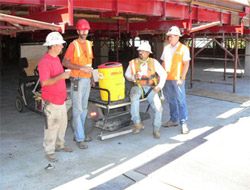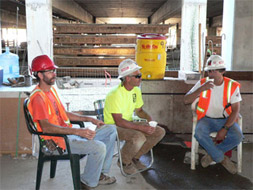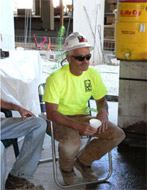 Heat Illness Prevention
Heat Illness Prevention 
Work Severity and Duration Elements of Your Written Program and Effective Work Practices
What is in T8CCR 3395?
T8CCR 3395(b) Definitions states the following:
“Environmental risk factors for heat illness” means working conditions that create the possibility that heat illness could occur, including air temperature, relative humidity, radiant heat from the sun and other sources, conductive heat sources such as the ground, air movement, workload severity and duration, protective clothing and personal protective equipment worn by employees.
T8CCR 3395(h) Training states the following:
(1) Employee training. Effective training in the following topics shall be provided to each supervisory and non-supervisory employee before the employee begins work that should reasonably be anticipated to result in exposure to the risk of heat illness:
(A) The environmental and personal risk factors for heat illness, as well as the added burden of heat load on the body caused by exertion, clothing, and personal protective equipment.
Guidance, Best Practices and Warnings
In order to prevent heat illness it is important to allow the body to cool down. By stopping physical work activities and replacing them with rest the body cools down. Providing cooling allows the body’s internal temperature to come closer to the "normal range" (i.e., within a very narrow temperature range above or below 98.6° F). Also, as the body cools heart rate and respiration slow down. The body cools during resting by:
- drinking water (see Sufficient Amounts of Drinking Water) and
- resting in adequate shade or using alternative measures which have been demonstrated to be equally effective (see Shade and Other Cooling Measures)
A rest break is not the same as a preventative cool down rest period (CDRP). Cal/OSHA requires that employees be given a CDRP if they are suffering from heat illness, or believe they need a CDRP (see Cool Down Rest Periods). Regular rest breaks help cool the body to eliminate the need for a CDRP. They involve alternating normal work activities with regularly scheduled rest breaks.
Best Practices
Work Severity and Duration Adjustments
In warm or hot weather and during high heat or a heat wave try to:
- Schedule slower paced, less physically demanding work during the hot parts of the day and the heaviest work activities during the cooler parts of the day (early-morning or evening) .
- Split-up work shifts to avoid work during the hottest part of the day.
- Start the work shift even earlier in the day or later in the evening
- Avoid over time work and double shifts.
- Postpone non-essential work to be done until a later time when it is cooler.
- Rotate employees through less physically demanding jobs
- Add extra personnel to reduce exposure time for each employee.
- Cut work shifts short or stop work altogether
Be aware that In spite of these measures heat illness can still develop.

Best Practices
Rest Breaks
The judgment and experience of supervisors or other designated person(s) who are at the worksite is vital when scheduling regular rest breaks. The timing, frequency, and length of these breaks needs to be based on:
- The temperatures and other risk factors present at the worksite at any given time throughout the workday
- Careful observation of employees behavior and physical condition
Remember, healthy employees are far more productive throughout the work shift and are also much less likely to develop heat illness or become injured. Ensure that your employees take their regularly scheduled breaks (and frequently drink sufficient amounts of water). It is important to:
- Train employees and supervisors to understand the importance of taking work rest cycles
- Use a "buddy system" to have supervisors and fellow employees watch each other closely at all times
- Recognize employees who have reduced work capacities because of personal risk factors and may need more flexible or additional work-rest cycles
- Provide more frequent breaks for employees performing tasks requiring constant attention (e.g., equipment operators) or wearing PPE
- Use portable structures (or other portable alternative cooling measures) for mobile crews. These measures can provide cooling during breaks for mobile crews as they change their work locations
- Provide areas for employees to take their breaks which are:
- Readily accessible
- Open to the air and ventilated or cooled, or in shaded areas
- Near sufficient supplies of drinking water



